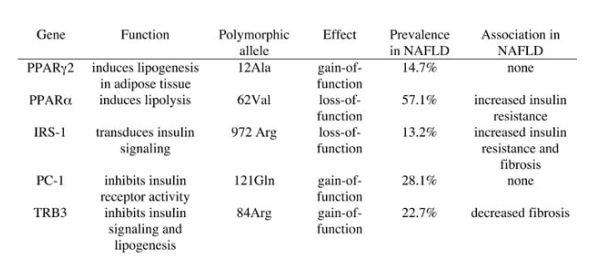 |
 |
 |
| |
Inherited Variants of Genes Involved in Insulin Signaling and Lipogenesis Influence The Risk of Hepatic Fibrosis in Nonalcoholic Fatty Liver Disease
|
| |
| |
EASL, April 2007, Barcelona, Spain
P. Dongiovanni 1, L. Valenti 1, R. Rametta 1, A.L. Fracanzani 1, S. Fargion 1 1 Department Of Internal Medicine, Universita Di Milano, Ospedale Policlinico IRCCS, Milano, Italy
Background & aims: Inherited factors play a major role in the
pathogenesis of the metabolic syndrome, whose hepatic expression is NAFLD, a leading cause of liver disease. The study aim was to assess the role of well-characterized functional polymorphisms of genes involved in insulin signaling and lipogenesis on the risk of NAFLD progression to fibrosis.
Patients and Methods: 235 patients with NAFLD, 150 with liver biopsy (57 with and 93 without fibrosis), and 135 controls. The Leu162Val PPARalpha, Pro12Ala PPARgamma2, Lys121Gln PC-1, Gly972Arg IRS-1, and Glu84Arg TRB3 polymorphisms were determined by restriction analysis (see Table). Data were compared by chi-square and t-Test, when appropriate. The risk of fibrosis was adjusted by logistic regression analysis considering as independent variables genetic polymorphisms, age, ALT, and ferritin levels.
Results:
At univariate analysis, the IRS-1 972Arg and the PPARalpha 162Val alleles, previously linked to insulin resistance, were associated with higher prevalence of diabetes/impaired glucose tolerance and higher HOMA insulin resistance index (p<.05).
The IRS-1 972Arg allele (prevalence 13% in NAFLD) was associated with higher prevalence of fibrosis in biopsied patients (55% in positive patients vs. 36% in negative ones; OR 2.5, 95% CI 0.99-7; p=.06), whereas the gain of function 84Arg allele (prevalence 23% in NAFLD) of TRB3, which inhibits lipogenesis, was associated with lower fibrosis (28% in positive patients vs. 43% in negative ones; OR 0.39, 95% CI 0.15-0.95; p=.04).
Conclusions:
Genetic factors affecting lipogenesis and insulin signaling, which regulates metabolism and survival of hepatocytes, are associated with the progression of liver damage in NAFLD.

|
| |
|
 |
 |
|
|